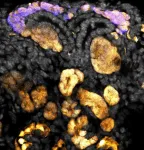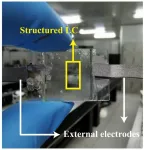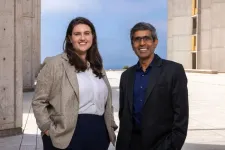(Press-News.org) FOR IMMEDIATE RELEASE
Monday, September 30, 2024
Contact:
Jillian McKoy, jpmckoy@bu.edu
Michael Saunders, msaunder@bu.edu
##
BU Professor Receives $29M NIH Grant to Study Dementia Risk Factors, Prevention, and Treatment
The Triangulation of Innovative Methods to End Alzheimer’s Disease project will use large, diverse datasets to examine whether interventions targeting alcohol use, depression, vision or hearing impairments, or social isolation can protect people from Alzheimer’s disease and related dementias. This project is a collaboration among Dr. Maria Glymour at Boston University School of Public Health, Dr. Jacqueline Torres at the University of California, San Francisco and Dr. Paola Gilsanz at the Kaiser Permanente Northern California Division of Research and colleagues at three other research institutions.
Up to 45 percent of Alzheimer’s disease and related dementias (ADRD) cases could be prevented by modifiable risk factors, but current research is limited to observational studies that make it difficult to establish definitive causes.
Dr. Maria Glymour, chair and professor of epidemiology at Boston University School of Public Health (BUSPH), Dr. Jacqueline Torres, associate professor, epidemiology & biostatistics at the University of California, San Francisco, and Dr. Paola Gilsanz, research scientist II at the Kaiser Permanente Northern California Division of Research, have received a $28.8 million grant from the National Institute on Aging to lead an ambitious initiative that will strengthen this research and develop more reliable evidence to guide prevention and treatment strategies for these degenerative neurological diseases.
The five-year award will support the Triangulation of Innovative Methods to End Alzheimer’s Disease (TIME-AD) project, which will integrate large, diverse datasets and apply cutting-edge causal inference methods to compare findings and quantify or correct biases in the results. Dr. Glymour co-leads the project with researchers from the University of California, San Francisco and the Kaiser Permanente Northern California Division of Research. The research team also includes researchers at the University of California, Los Angeles, Harvard University, and Kaiser Permanente Northwest. This unique collaboration will enable more definitive evidence than previously achievable.
“Preventing diseases like Alzheimer's and other causes of memory loss and dementia is among the highest priority for older adults, yet, we still lack rigorous evidence on what works,” says Dr. Glymour, whose research spans dementia risk and age-related cognitive decline, as well as the social inequalities that persist in unhealthy aging. “Day-to-day decisions or routine medical care may help ensure older individuals maintain healthy brains. The TIME-AD project aims to deliver the best possible evidence on how much these opportunities can make a difference to delay or prevent dementia.”
More than 10 million people worldwide are diagnosed with a form of dementia each year, with Alzheimer’s disease contributing to the majority of new cases. Some estimates suggest that more than 1 in 4 people think there is nothing they can do to prevent dementia, but a wealth of data suggests otherwise. As there remains no cure for ADRD, it is a public health priority to better understand how to reduce everyone’s risk of developing ADRD.
For the TIME-AD project, the research team will investigate four major modifiable risk factors for ADRD: lifetime alcohol use, depression, vision and hearing impairments, and social isolation, aiming to provide more comprehensive and convincing data that could explain whether and to what extent these risk factors contribute to ADRD risk.
“These risk factors were each chosen because we already know how to change them,” Dr. Glymour says. “If our study demonstrates these interventions make a difference, then individuals, families, healthcare systems, and policymakers can immediately start to act on that evidence to reduce the epidemic of Alzheimer's disease and dementia.”
The team will prioritize health equity throughout their work, examining potential differences in risk by gender, race/ethnicity, and socioeconomic status. ADRD inequities are a major challenge in the United States. For example, Black and Latino people are more likely to develop Alzheimer’s disease than White people—but less likely to be diagnosed. Many studies use data sets that are too small to identify the factors that lead to disparities by gender, race/ethnicity, or socioeconomic status. By combining multiple data sets, TIME-AD will have statistical power to better address ADRD risk in diverse populations.
“We have an extraordinary team of health researchers collaborating on this project because we recognize both the urgency of the questions and the potential for progress,” says Dr. Glymour.
Several BUSPH researchers are coinvestigators of this project, including Dr. Rhoda Au, professor of epidemiology; Dr. Ruijia Chen, postdoctoral associate in the Department of Epidemiology; Dr. Yvette Cozier, associate dean for diversity, equity, inclusion & justice and professor of epidemiology; Dr. Phillip Hwang, assistant professor of epidemiology; Dr. Marcia Pescador Jimenez, assistant professor of epidemiology; Dr. Koichiro Shiba, assistant professor of epidemiology; and Dr. Justin White, associate professor of health law, policy & management.
**
About Boston University School of Public Health
Founded in 1976, Boston University School of Public Health is one of the top ten ranked schools of public health in the world. It offers master's- and doctoral-level education in public health. The faculty in six departments conduct policy-changing public health research around the world, with the mission of improving the health of populations—especially the disadvantaged, underserved, and vulnerable—locally and globally.
END
BU professor receives $29M NIH grant to study dementia risk factors, prevention, and treatment
Led by Maria Glymour, the project will use large, diverse datasets to examine whether interventions targeting alcohol use, depression, vision or hearing impairments, or social isolation can protect people from Alzheimer's and related dementias.
2024-09-30
ELSE PRESS RELEASES FROM THIS DATE:
Ninth Circuit reverses lower court, reinforces FDA's authority to regulate unproven stem cell products
2024-09-30
In an important step to protect the public from unproven stem cell products, the U.S. Court of Appeals for the Ninth Circuit ruled in favor of the U.S. Food and Drug Administration in U.S. v. California Stem Cell Treatment Center, Inc., reversing the district court. The reversal fortifies FDA’s tiered, risk-based framework for the regulation of cell therapies and is consistent with a similar ruling in the Eleventh Circuit in 2021.
The appellees urged the Ninth Circuit to uphold the lower court’s ...
Wnt happens in kidney development?
2024-09-30
A group of essential signaling molecules known as the Wnt pathway emerged early in the evolution of multicellular life. Scientists have been studying Wnt actions for four decades to comprehend its complex roles in development and disease. In development of the mammalian kidney, USC Stem Cell scientists from Andy McMahon’s lab undertook a pair of complementary studies, published today in the journal Development, that provide new insight into the critical role of Wnt signaling in initiating the development of the mammalian kidney.
“Many stem and progenitor cells require Wnt signaling, ...
Where flood policy helps most — and where it could do more
2024-09-30
Flooding, including the devastation caused recently by Hurricane Helene, is responsible for $5 billion in annual damages in the U.S. That’s more than any other type of weather-related extreme event.
To address the problem, the federal government instituted a program in 1990 that helps reduce flood insurance costs in communities enacting measures to better handle flooding. If, say, a town preserves open space as a buffer against coastal flooding, or develops better stormwater management, area policy owners get discounts on their ...
Combining AI and thermal video offers a new window into weightlifting
2024-09-30
WASHINGTON — Researchers have developed a new method that combines video from thermal cameras with AI-based digital processing to enhance weightlifting training. By providing data-driven insights that enable targeted training and recovery strategies, the approach could help to optimize performance and safety in a variety of sport and exercise contexts.
Thermal, or infrared, images can provide valuable information for sports and health by tracking muscle activation and detecting areas of strain or fatigue. This information can be used to prevent injuries, monitor thermal responses and quantify physical exercise, ultimately helping athletes boost their skills. However, most ...
Childhood social interactions combat stereotypes
2024-09-30
Prior research has found that exposure to social diversity in early life, such as through day care, influences how people communicate.
Those early social experiences can also moderate tendencies toward stereotyping down the road, according to a new study published in the NPJ Science of Learning.
"The more time an individual spent in day care as a child, the more likely they are to overcome their own stereotypical beliefs during social interactions later in life," says senior author Arjen Stolk, an assistant professor in the Department ...
Researchers harness liquid crystal structures to design simple, yet versatile bifocal lenses
2024-09-30
WASHINGTON — Researchers have developed a new type of bifocal lens that offers a simple way to achieve two foci (or spots) with intensities that can be adjusted by applying external voltage. The lenses, which use two layers of liquid crystal structures, could be useful for various applications such as optical interconnections, biological imaging, augmented/virtual reality devices and optical computing.
“Most liquid-crystal-based devices are made from single-layer structures, but this limits light field modulation ...
Suicide attempts decreased after adding suicide care to primary care, study finds
2024-09-30
After suicide care was integrated into routine primary care visits, researchers saw a 25% decrease in the rate of suicide attempts in the following 90 days, a new Kaiser Permanente study finds.
The study, published in the Annals of Internal Medicine, is the first to show that suicide risk screening in primary care, followed by safety planning, improved suicide prevention efforts in a health care setting. The trial took place at Kaiser Permanente clinics in Washington state, using data from January 2015 to July 2018.
“Our findings are important because we know many people seek primary care prior to fatal and nonfatal suicide attempts,” ...
One in three Americans has a dysfunctional metabolism, but intermittent fasting could help
2024-09-30
LA JOLLA (Sept 30, 2024)—More than one-third of adults in the United States have metabolic syndrome, a cluster of conditions that significantly raise a person’s risk of heart disease, stroke, and type 2 diabetes. These conditions include high blood pressure, elevated blood sugar, excess abdominal fat, and abnormal cholesterol levels.
In a new clinical trial, researchers at the Salk Institute and University of California San Diego School of Medicine found that time-restricted eating—also known as intermittent fasting—could offer significant health benefits to adults with metabolic syndrome. Patients ...
Time-restricted eating associated with greater blood sugar control and fat loss than standard nutrition counseling
2024-09-30
Embargoed for release until 5:00 p.m. ET on Monday 30 September 2024
@Annalsofim
Below please find summaries of new articles that will be published in the next issue of Annals of Internal Medicine. The summaries are not intended to substitute for the full articles as a source of information. This information is under strict embargo and by taking it into possession, media representatives are committing to the terms of the embargo not only on their own behalf, but also on behalf of ...
New imaging technique brings us closer to simplified, low-cost agricultural quality assessment
2024-09-30
URBANA, Ill. – Hyperspectral imaging is a useful technique for analyzing the chemical composition of food and agricultural products. However, it is a costly and complicated procedure, which limits its practical application. A team of University of Illinois Urbana-Champaign researchers has developed a method to reconstruct hyperspectral images from standard RGB images using deep machine learning. This technique can greatly simplify the analytical process and potentially revolutionize product assessment in the agricultural industry.
“Hyperspectral ...
LAST 30 PRESS RELEASES:
Why nail-biting, procrastination and other self-sabotaging behaviors are rooted in survival instincts
Regional variations in mechanical properties of porcine leptomeninges
Artificial empathy in therapy and healthcare: advancements in interpersonal interaction technologies
Why some brains switch gears more efficiently than others
UVA’s Jundong Li wins ICDM’S 2025 Tao Li Award for data mining, machine learning
UVA’s low-power, high-performance computer power player Mircea Stan earns National Academy of Inventors fellowship
Not playing by the rules: USU researcher explores filamentous algae dynamics in rivers
Do our body clocks influence our risk of dementia?
Anthropologists offer new evidence of bipedalism in long-debated fossil discovery
Safer receipt paper from wood
Dosage-sensitive genes suggest no whole-genome duplications in ancestral angiosperm
First ancient human herpesvirus genomes document their deep history with humans
Why Some Bacteria Survive Antibiotics and How to Stop Them - New study reveals that bacteria can survive antibiotic treatment through two fundamentally different “shutdown modes”
UCLA study links scar healing to dangerous placenta condition
CHANGE-seq-BE finds off-target changes in the genome from base editors
The Journal of Nuclear Medicine Ahead-of-Print Tip Sheet: January 2, 2026
Delayed or absent first dose of measles, mumps, and rubella vaccination
Trends in US preterm birth rates by household income and race and ethnicity
Study identifies potential biomarker linked to progression and brain inflammation in multiple sclerosis
Many mothers in Norway do not show up for postnatal check-ups
Researchers want to find out why quick clay is so unstable
Superradiant spins show teamwork at the quantum scale
Cleveland Clinic Research links tumor bacteria to immunotherapy resistance in head and neck cancer
First Editorial of 2026: Resisting AI slop
Joint ground- and space-based observations reveal Saturn-mass rogue planet
Inheritable genetic variant offers protection against blood cancer risk and progression
Pigs settled Pacific islands alongside early human voyagers
A Coral reef’s daily pulse reshapes microbes in surrounding waters
EAST Tokamak experiments exceed plasma density limit, offering new approach to fusion ignition
Groundbreaking discovery reveals Africa’s oldest cremation pyre and complex ritual practices
[Press-News.org] BU professor receives $29M NIH grant to study dementia risk factors, prevention, and treatmentLed by Maria Glymour, the project will use large, diverse datasets to examine whether interventions targeting alcohol use, depression, vision or hearing impairments, or social isolation can protect people from Alzheimer's and related dementias.




